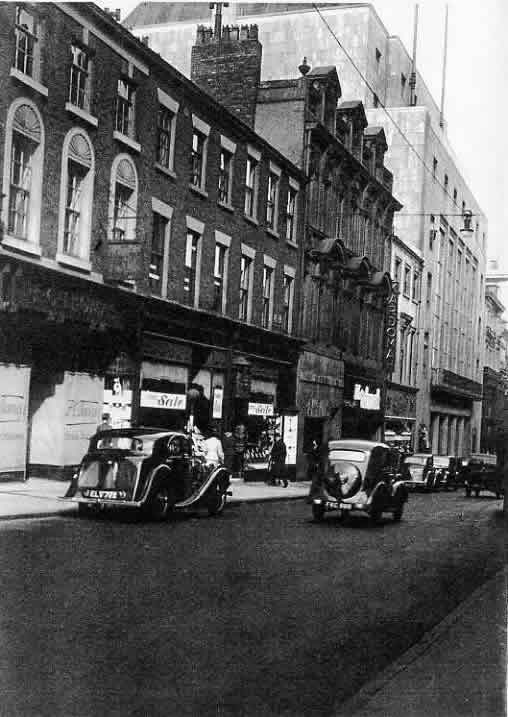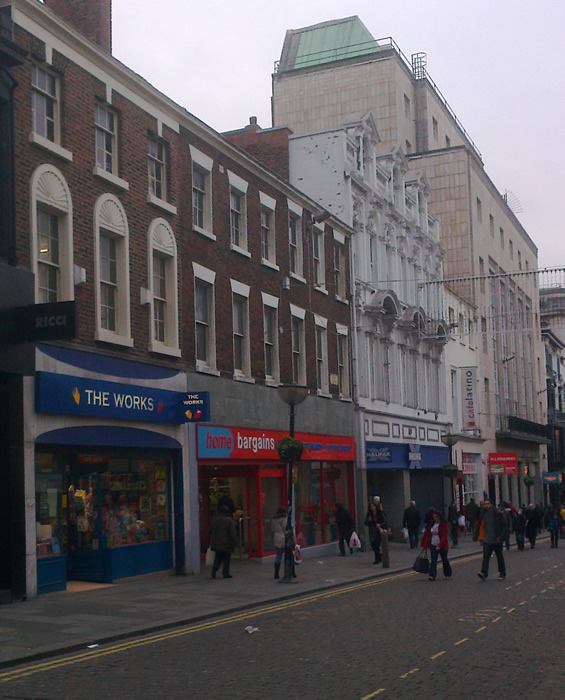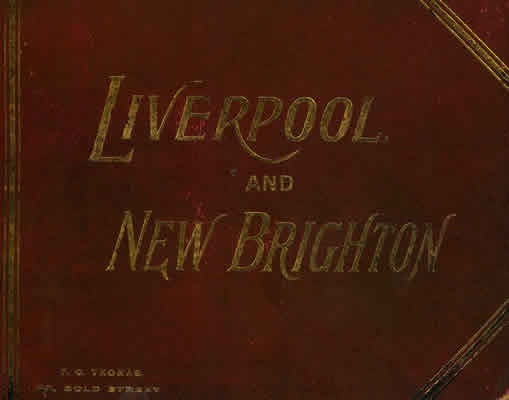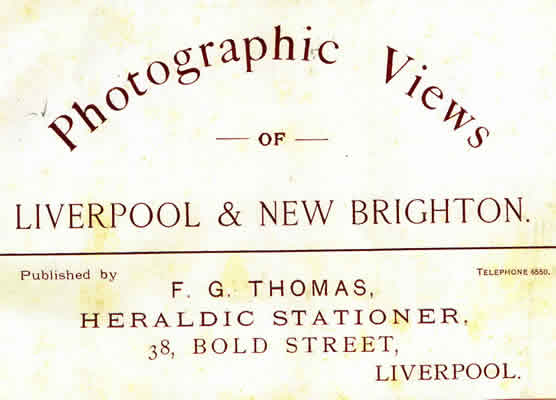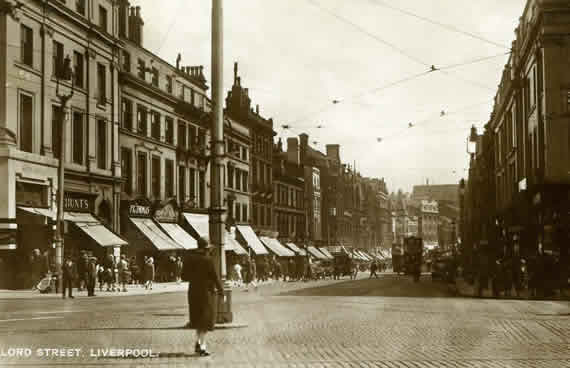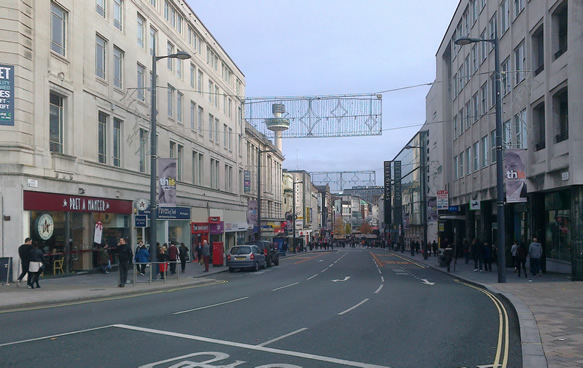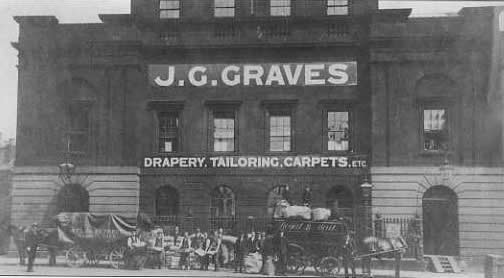The History of F.G.Thomas |
|||||
- |
|||||
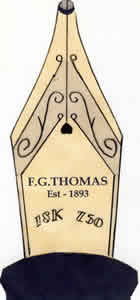 |
|||||
F.G.THOMAS - LIVERPOOL |
|||||
Frederick George Thomas was born in the summer of 1861 in Manchester, England and named after his father who was a commercial traveller. Frederick was a bookseller living in Wigan when he married his wife Mary Helen Walton in Manchester in 1884. By 1891 the Thomas Family were living on Park Road in Wigan with their two children, Ethel aged 5 and Edith 4, Mr Thomas's job description was now a Stationer. |
|||||
The Bold Street branch of F.G.Thomas was opened at no 38 in 1893, before this date the premises were occuppied by Mole Keartland, Florist and Fruiterer. As you can see from the two pictures shown below , the buildings on this part of Bold street have seen very little change in 75 years. |
|||||
|
|||||
- |
|||||
By 1901 the Thomas Family were living in the Toxteth Park area of Liverpool, and the Lord Street Branch of F.G.Thomas was also opened in the early part of the 20th Century at No5, which is the first shop on the left hand side of the picture, the postcard dates from 1910. |
|||||
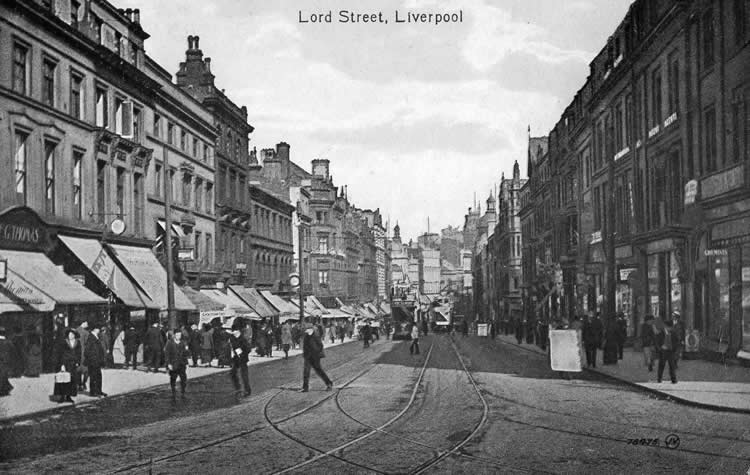 |
|||||
- |
|||||
F.G.Thomas advertised as an heraldic stationer and published postcards and photograpic booklets, shown below is the cover and book plate from a picture book of Liverpool and New Brighton. |
|||||
|
|||||
- |
|||||
The images below shows a bustling scene on Lord Street in the 1920's. |
|||||
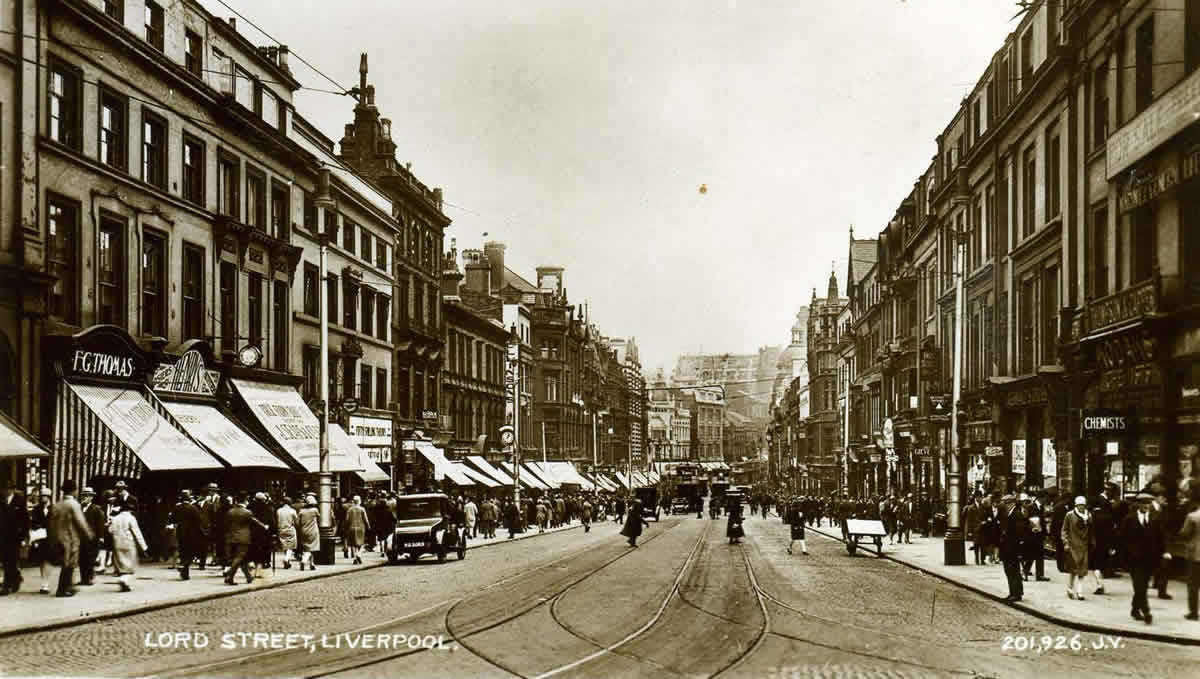 |
|||||
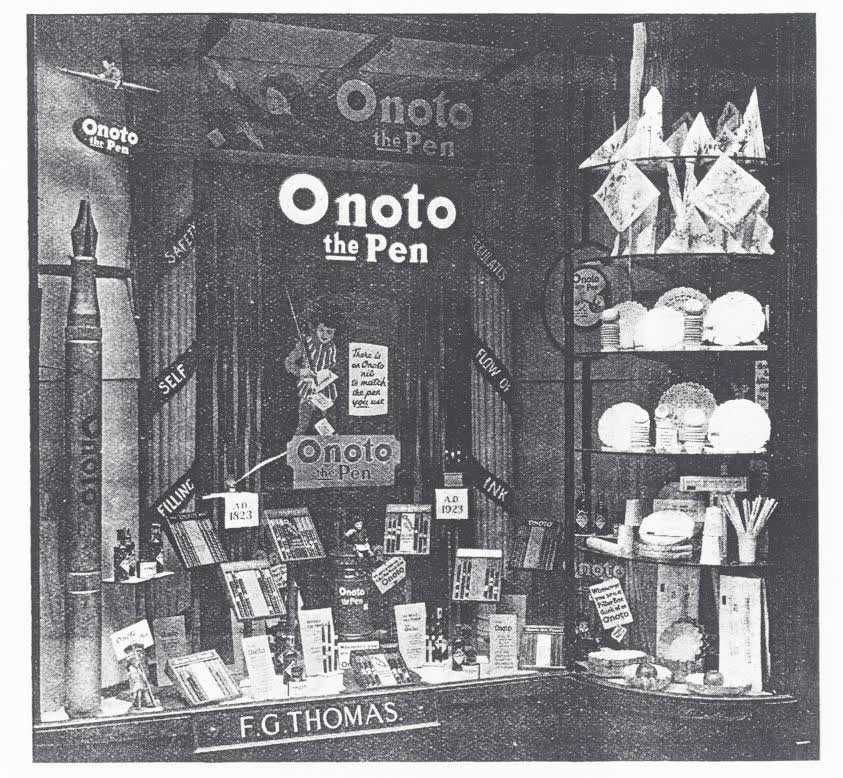 |
|||||
The above image above was kindly donated by Steve Hull and is featured in his book, Onoto The Pen: De La Rue & Onoto Pens 1860-1960, due for publication in October 2016. The display was at the Bold Street shop in Liverpool, and it won the Onoto Window Display Competition of early 1924 with a first prize of £50, in 2015 that would be worth around £2700 in todays money. |
|||||
F.G.Thomas had a very active life away from his business, a member of the Liverpool congregational council for many years and in 1925 was appointed the president of the council, he was also a deacon for over 30 years at the George St congregational church. Mr Thomas was a prominent member of the Liverpool Rotary Club, while he was also well known to be a generous subscriber to charitable and religious works |
|||||
- |
|||||
His other interests included being a member of the committee of the Liverpool Sunday School Union and of the committee of the Liverpool Y.M.C.A . He was also treasurer of the Merseyside Training Centre for Sunday School teachers and a manager of the Liverpool School for the Deaf and Dumb . |
|||||
- |
|||||
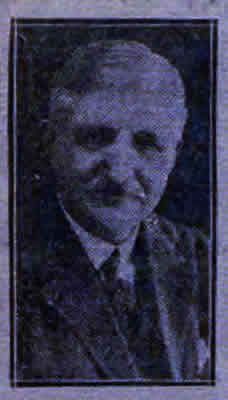 |
|||||
Mr. F.G.Thomas 1861-1930 |
|||||
- |
|||||
- |
|||||
The Lord street area of Liverpool city centre sustained heavy damage during the blitz of World War II, and you can see how the designs of the buildings change after the war by compairing the two images below. |
|||||
|
|||||
- |
|||||
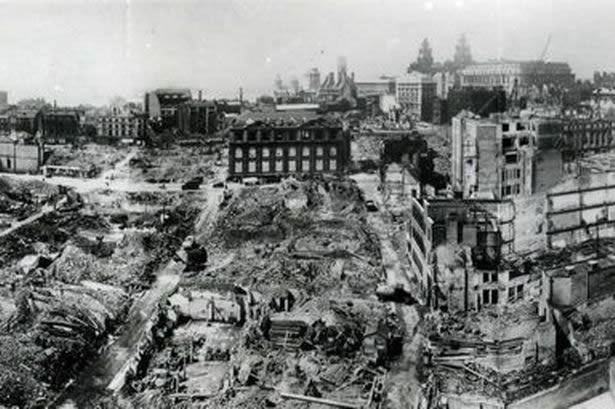 |
|||||
Liverpool City Centre after the May Blitz of 1941 |
|||||
- |
|||||
-My resaerch |
|||||
My research into F.G.Thomas Liverpool is still on going, and from the little information I can find on the internet it's seems the Bold St shop closed down sometime in the late 1960's. |
|||||
-F.G |
|||||
Further information as come to light recently and although at this time I have no record of these shops, it seems there was another three F.G.Thomas stores in England. When the Bold St shop closed it was moved to Matthew St, a street famous for the cavern club. There was a branch in Ellesmere Port on Rivington Road, and also one in Brighton. |
|||||
F.G.Thomas Sheffield - Past and Present.
|
|||||
F.G.Thomas was established in Sheffield in 1913 at 24 Angel street in the heart of the city centre. Advertisments dating from the 1920's in todays equivalent of the yellow pages had the shop listed as heraldic stationers,printers and sellers of fine gifts.Some of my more elderly customers told me the Angel street shop was more of a departmental store selling a large variety of goods.One lady told me the story of the nightmares she had as a child when seeing dead baby chicks sold at easter by F.G.Thomas.She seemed to hold me responsable for this around 70 years later. |
|||||
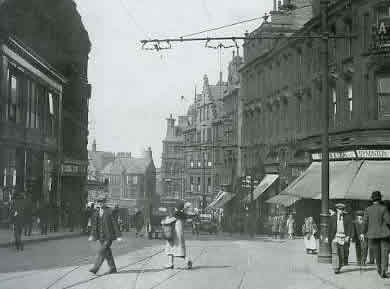 |
|||||
Angel St In the 1930's, F.G.Thomas is the second store down on the right hand side. |
|||||
The Surrey Street branch of F.G.Thomas was opened in 1925 at number 25.Before this, the shop was occupied by Charles Snidall , printers and stationers ,who had been there from the early 1890's. |
|||||
In 1891 J.G.Graves Watch Repairer,was listed as the shops occupier.John George Graves went on from these small roots to become one of Sheffields most famous figures.He established himself the largest mail order company of its time in the early 20th century selling an assortment of fine gifts.You can still find J.G.Graves pocket watches on antique dealers websites and at auction houses .He was also a generous man,giving away over a £1m of his fortune during his lifetime. Contributing £30,000 towards the building of the Central Library and Graves art gallery on Surrey Street was one in a long list of gifts to the city. |
|||||
J.G.Graves Mail order business warehouse in the Music Hall Surrey st 1902.Charles Dickens once performed at the Music Hall on a visit to Sheffield. |
|||||
During the late 1920's in an attempt to offset the Depression,two English companies manufactured fountain pens for commercial customers which they engraved with the customers details.The Mentmore Manufacturing Co was the first to undertake this work.The other company was Conway Stewart who continued to offer this service into the 1930's to stationers who sold their pens.I recently purchased an example of a 1930's Conway Stewart fountain pen which would have been sold in the F.G.Thomas(Sheffield) outlets. |
|||||
 |
|||||
GREEN MARBLED CONWAY STEWART FOUNTAIN PEN CIRCA 1930's, ENGRAVED-F.G.THOMAS, LEVER SELF FILLING PEN,24 ANGEL ST & 25 SURREY ST,SHEFFIELD. |
|||||
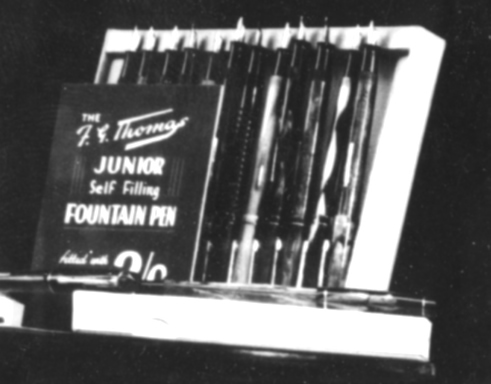 |
|||||
F.G.Thomas window display from the Parker England, Newhaven archives. |
The F.G.Thomas self filling pens for sale . |
||||
| The Angel street branch had been in business for twenty seven years when on the evenings of the 12th and 15th of December 1940 during WWII Sheffield city centre was razed to the ground.During two raids German aircraft dropped somewhere in the region of 450 bombs on Sheffield.The Angel street area of the city centre took a direct hit most of the buildings were destroyed or damaged, causing them to be demolished later.The Angel street branch never reopened ,but part of the store can still be seen today.A member of F.G.Thomas's staff sorted through the rubble after the Sheffield Blitz and salvaged four heraldic plaques.These plaques were fixed to the outside of the Surrey street store and remain there to this day. | |||||
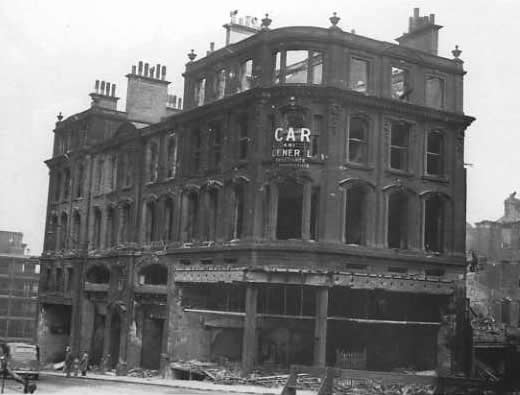 |
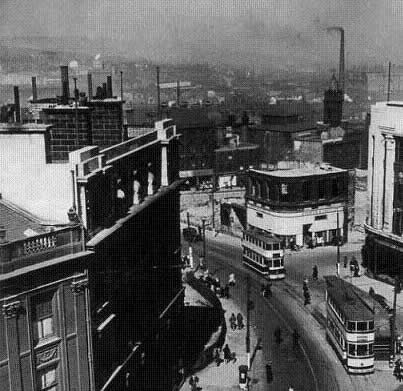 |
||||
Angel St in 1940 after the Sheffield Blitz. F.G.Thomas's shop can be seen gutted by fire. |
Angel st in 1943.Syminton & Croft on the corner re-opened for business during the war. No 24 can still be seen gutted next door,the block was demolished and Castle house co-op was built after the war. |
||||
The Surrey street store was run by the same two employees for many years ,two sisters in fact.One ran the basement selling cards and cake decorations;the other,called Agnes,ran the upstairs stationery department.The two sisters must have run the store for many years,because most of the customers who told me about them thought they owned F.G.Thomas.When I purchased F.G.Thomas in 1990 Anne was the manageress,who was,in fact,Agnes's daughter.When the owner decided to sell the business,all of Anne's staff left for other jobs leaving her to run the store on her own.This forced Agnes out of retirement when she was well into her 70's.I can still remember her taking priority over everyone else when a customer came in to purchase a pen. |
|||||
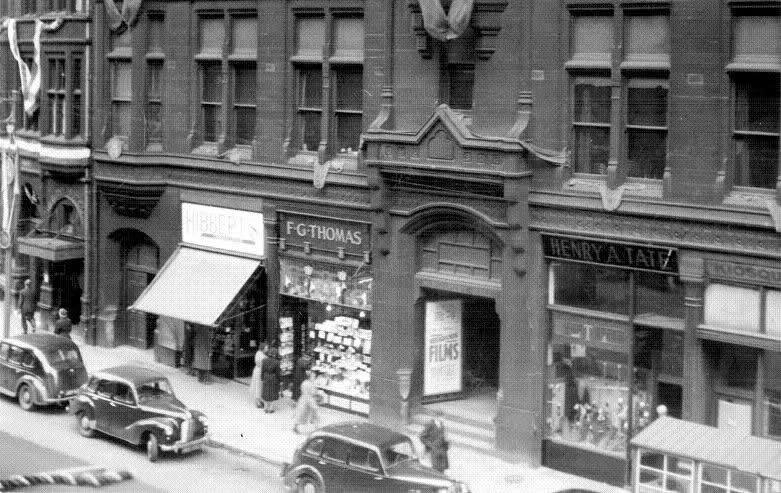 |
|||||
F.G.Thomas,Surrey St in 1953. |
|||||
The store stocked mainly Sheaffer and Cross pens,with a small selection of Parker and Elysee.We started to introduced more Parker pens into the shop the 25's, 45's, 75's, 95's and Duofolds represented a great range of pens to sell in the early ninties The shops main trade was stationery with the basement selling account books,printed wedding stationery and general stationery .The upstairs was open shelving stock with stationery , microfile organisers, leatherware etc.The basement is now close to the public and is used as a workshop and storage area.The upstairs has also changed with glass display cabinets replacing the open shelving. Between 1990 and 2008 certain pen models have had good runs. A few that spring to mind are,the Diplomat's Classic.Waterman's Exclusive,L'etalon and Laureat and Elysee's slimline tortoiseshell and cobra. Sheaffer pens have always been a favorite of mine, the Targa being one of the better selling models with such a large range in price and finishes to cover most customer needs.The Sheaffer Connaisseur was a quality pen but our customers seemed to prefer the Parker Duofold.With the Targa,Connaisseur,Crest,TRZ/Fashion,Oldtimer,Triumph and then later the Balance, Legacy and Prelude. Sheaffer become our best selling range of pens over our first decade of trading.Sadly this is no longer the case and with production stopping in Fort Madison i wonder if we will ever see Sheaffer back as a force in the modern pen trade. Now the brands we sell most are Lamy,Cross and Montblanc.I still stock Sheaffers,Parkers,Watermans but they just don,t seem to appeal to the everyday customer like they did in the past.Visconti and Montegrappa give us something different in terms of colour and flare.At the lower price point Fisher Space pens are still popular and Faber Castell have sold well recently.
|
|||||
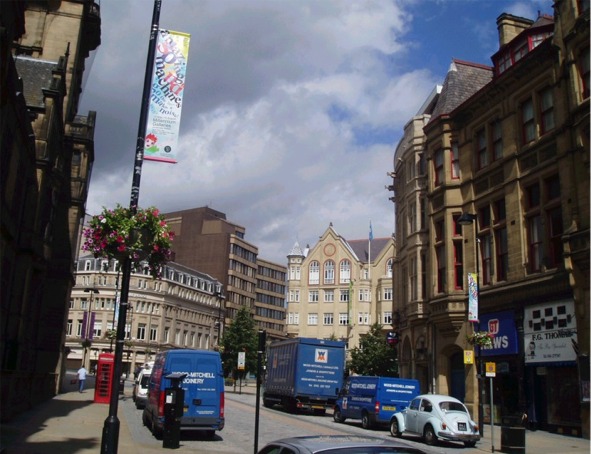 |
|||||
Surrey St in 2003 |
|||||
I never really appreciated the companys past when we first bought the shop 18 years ago.Purchasing the Conway Stewart pen made me curious to find out more about the history of F.G.Thomas. It's been interesting researching into the history of Sheffield and F.G.Thomas.It makes you feel very nostalgic searching through the books at the local history section at central library on Surrey Street,Sheffield. |
|||||
